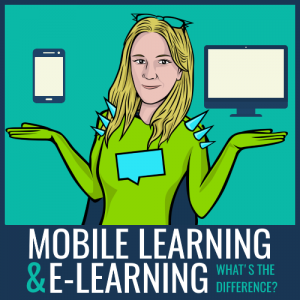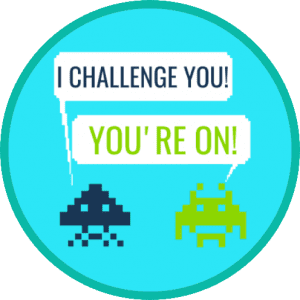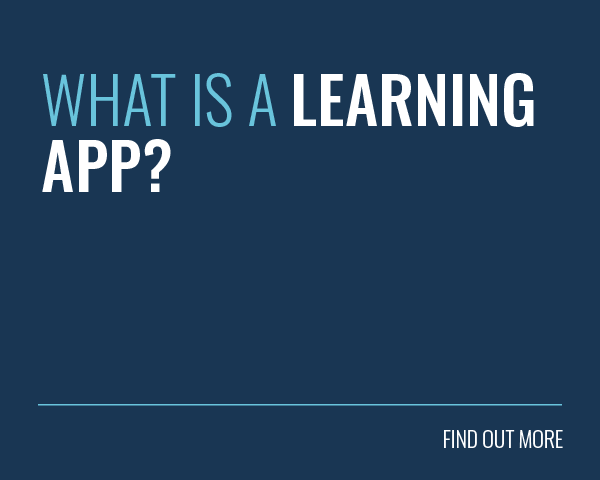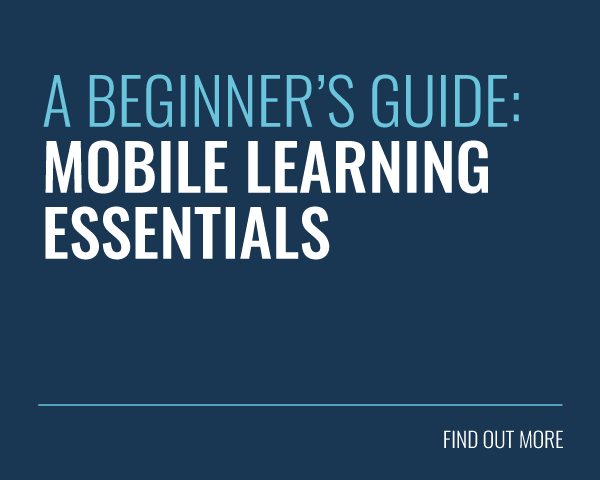 You might think mobile learning is just classic eLearning on a smaller screen, but it’s not that simple. To start with, the term ‘eLearning’ can be fuzzy enough on its own, depending on who you’re talking to. To some people, eLearning defines the entire field of computer-based training and they see it as a synonym of online learning.
You might think mobile learning is just classic eLearning on a smaller screen, but it’s not that simple. To start with, the term ‘eLearning’ can be fuzzy enough on its own, depending on who you’re talking to. To some people, eLearning defines the entire field of computer-based training and they see it as a synonym of online learning.
To other people, when they speak about eLearning, they’re talking specifically about our friend, the SCORM-compliant package that’s uploaded onto a learning management system. It’s not for us to say who’s right and who’s wrong – but for the purposes of this article, we’re going with the second definition.
So, what’s the difference between an eLearning unit and mobile learning content?
The Difference Between Mobile Learning and e-learning
The Length
 First and foremost, the key thing that defines eLearning-of-old and mobile learning content is the length of time it takes the learner to complete a part of it.
First and foremost, the key thing that defines eLearning-of-old and mobile learning content is the length of time it takes the learner to complete a part of it.
Generally speaking, the purpose of traditional eLearning units is to package a concept up in a single file, comprised of a number of screens or slides. These might contain text, video or interactive elements like multiple choice questions. Overall, an eLearning unit might take the learner anything between 15 minutes and an hour to complete.
If the learner is out and about and manages to find a spare 5 minutes, taking a full-length eLearning unit on a mobile device isn’t very practical. Because of the way mobile devices are used, mobile learning has to deliver the content in a more bite-sized way.
The Instructional Approach
Because the learners will access the content in a sporadic way, the same approach to creating an eLearning unit won’t necessarily work in a mobile context. The majority of eLearning units will start with a learning objective, and follow a linear journey, covering off all of the points until that objective has been communicated.
Instructional designers need to modify their approach when creating mobile learning content. They need to assume that the learner will dip in and out of the content over an extended period of time and it’s important that what they learn in each session will be retained until the next one. Depending on the topic, this approach might demand some creative thinking, but it’s not the end of the world if you veer off track because…
 Mobile is more interactive
Mobile is more interactive
Since the learners will access mobile learning on a more frequent basis, learning managers can run regular reports and fine-tune their approach. This regular feedback means that while the learners are learning about how to do their jobs, the entire L&D team is learning about what works and what doesn’t.
The innate interactivity of mobile also presents a challenge. Mobile users have grown to expect a certain standard when it comes to user experience, and it’s essential that mobile learning content can compete with other mobile apps and hold the learners’ attention. If you consider how most people use their mobile devices – they’ll seldom use the same app for any length of time before a notification pops up prompting them to switch to something else.
Also, if we look at the statistics for the most popular categories on Apple’s app store, games surge ahead of the competition with 23.35% of the total. With mobile gaming seeing such popularity, we can conclude that people prefer the interactivity that games provide.
Is mobile learning better than eLearning?
 Mobile learning and eLearning might have their differences, but the delivery method won’t determine the success of the training programme. The most powerful training happens when the learner is fully engaged with the content. The mobile age has simply created even more new opportunities to do just that!
Mobile learning and eLearning might have their differences, but the delivery method won’t determine the success of the training programme. The most powerful training happens when the learner is fully engaged with the content. The mobile age has simply created even more new opportunities to do just that!
Instructional designers need to throw away the rule book if they are to capitalise on the addictive potential of mobile learning. In place of the old order, these instructional designers should seek inspiration from the most popular mobile games.
Instead of exposing your learners to a gripping 15-minute tutorial video for a new project planning system, gradually set challenges over the course of a few weeks. It doesn’t have to be a massive, herculean feat – the first challenge might just be to log in to the system for the first time.
At the very least, a ‘challenge’ is more fun than a ‘learning objective’, and when your learners are having fun, they’re more likely to engage with their training. Click the button below to find even more ways to build a successful mobile learning programme that your learners can’t resist!









